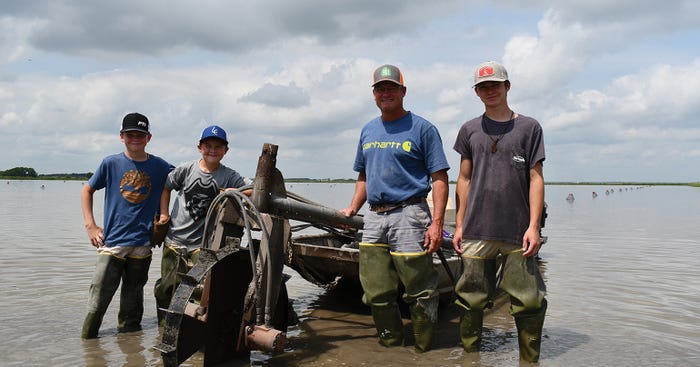
Luke, John David, Paul, and Jude Johnson in front of their boat made for collecting crawfish.Brian Ireland
When not growing rice, Paul Johnson uses crawfish farming and waterfowl hunting to round out his family farming operation. His wife and kids are an integral part of the business and lifestyle, in which they are active participants.
Johnson was inspired by working with family members as he grew up and now, he shares that opportunity with his family.
“My amazing wife homeschools the kids and we teach them about hard work around the farm,” he said. “When the kids are not in school, they are working on a 70-acre section of the farm. We helped them earn a spot to practice growing rice and raising crawfish, all while earning money for their futures.”
Johnson grows multiple varieties of rice depending on the market but will focus on Jazzman for 2022. The Jazzman variety is a premium long-grain rice that is in high demand. It is aromatic and is known for its soft-cooking characteristic.
“We’ve been growing Jazzman for about 10 years now,” he said. “Over time, we’ve increased the acreage of Jazzman to accommodate market demand. This year we will target around 75% of the total acreage in Jazzman. All of the rice is pre-contracted before it’s harvested.”
Johnson works with the mills to presell the expected yield. This helps him to plant exactly what is needed to minimize excess cost. This also helped build a strong relationship with the mill.
“During a hurricane, the roof was ripped off of the grain storage building,” he said. “Supreme Rice Mill immediately jumped on the issue and saved the inventory from spoiling. Having this relationship is extremely important and can save you in tough times.”
Winter months
Johnson begins flooding the fields in November. During the winter, the rice fields will be used for waterfowl hunting. In February, the water in the field will be stirred up, prior to seeding. The seed can then be planted by plane.
“We found that water seeding by airplane is the most efficient and economical method,” he said. “This prevents us from having to wait for the land to dry up enough to plant a crop or work the soil.”
The fields stay flooded, except for a five to six-day period after seeding, to prevent winter weeds from emerging. Johnson ensures flexibility by having the ability to plant drill seeded or water seeded depending on the market and year.
“This year was challenging with high winds causing wave action in the water-seeded fields,” he said.
Each plane is set up with the hopper and a spreader required to regulate the precise poundage of seed or fertilizer being applied.
“For best yields, plant the first week of March to beat the summer heat,” he said. “This helps avoid diseases later in rice and gives farmers a better chance of missing the peak hurricane season, where the crop can be destroyed by wind damage or worse.”
Soil samples are taken each fall to determine any fertilization requirements.
Irrigation strategy
Irrigation water is provided by surface water from the Lacassine Bayou.
“Having a canal system nearby is a huge benefit to farmers and large cost savings,” he said.
The canal water is pumped onto the fields and circulated as needed using flood gates. The fields are leveled to assist with drainage and ditches are created to help move water through the fields.
“For our area, we don’t have an issue getting water to the crop,” he said. “We have an issue getting rainwater off the property after a heavy rainfall.”
If planted early enough, most farmers can get a second crop out of the rice, also known as a ratoon crop.
“In order to harvest our ratoon crop, we strive to have every acre planted by April,” he said. “This ensures we harvest in mid to late October.”
Once the ratoon crop is harvested, water is immediately put on the fields for the waterfowl season. Hunters and waterfowl management decide the depth of water, typically five to six inches, that will remain on the field during the hunting season.
Waterfowl hunting remains a major part of the operation.
“We are experimenting with millet as a cover crop to benefit waterfowl,” he said.
Johnson thrives at instilling the value of working hard in his children and serving the local community.
Participation is important
Johnson participates at the parish, state, and national levels. Working with the Jeff Davis Parish Rice Growers Association, Louisiana Rice Growers Association, and the U.S. Rice Federation, Johnson represents farmers and helps build a stronger industry. This has been beneficial when urgent matters arise.
“If there is an emergency approval required for a pesticide that could save farmers that season, we work together diligently to ensure the necessary steps are followed to get it approved.”
The rice industry is facing challenges like other commodities such as issues with trade, issues with the logistics of imports/exports, and natural disasters or emergency outbreaks of pests.
The crawfish production side is for the kids to learn, develop skills, and earn a little money.
The rice stubble remains in the fields after harvest for crawfish to forage on. A shallow flood occurs in October to encourage the crawfish to come up and lay babies. The water level is controlled as crawfish don’t prefer warm water.
“We target roughly 10 traps per acre,” he said. “Early in the year, we will use catfish, buffalo, and shad for bait. Around March or April, we swap to an artificial cube.”
Apple Snails, an invasive pest, have increased in population over the past five years. Copper sulfate is an effective treatment option but detrimental to aquatic life such as crawfish.
About the Author(s)
You May Also Like




